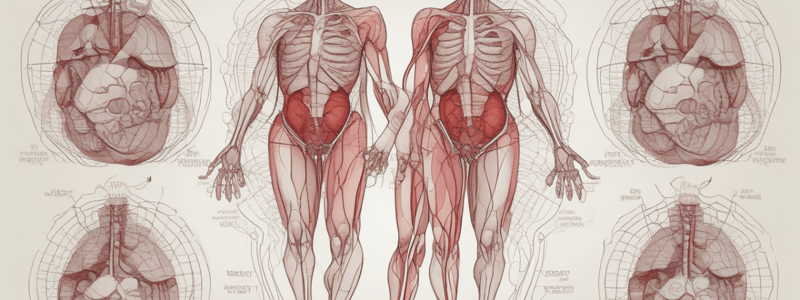Podcast
Questions and Answers
What is the function of the septum in the heart?
What is the function of the septum in the heart?
- To pump oxygenated blood to the rest of the body
- To regulate the heart's contractility and rate
- To maintain electrical isolation between the atria and ventricles (correct)
- To remove waste products from the tissues
Which of the following chambers has thicker walls?
Which of the following chambers has thicker walls?
- Myocardium
- Atria
- Septum
- Ventricles (correct)
What is the myocardium composed of?
What is the myocardium composed of?
- Cardiac valves
- Cardiomyocytes (correct)
- Electrical impulses
- Septum
What is the function of the ventricles?
What is the function of the ventricles?
What is the function of the atria?
What is the function of the atria?
What innervates the myocardium?
What innervates the myocardium?
Flashcards are hidden until you start studying
Study Notes
Heart Anatomy
The heart is a muscular organ that serves as the core of the circulatory system in the human body. It is responsible for delivering oxygen-rich blood to tissues and organs while removing waste products. The heart is divided into four chambers, two atria (upper chambers) and two ventricles (lower chambers), by a muscular wall called the septum.
Septum
The septum is a muscular wall that separates the left and right sides of the heart. It is composed of myocardium, the muscular tissue of the heart. The atria and ventricles have distinct electrical properties, and the septum helps maintain this electrical isolation, ensuring that the atria and ventricles contract in a coordinated manner.
Ventricles
The ventricles are the two lower chambers of the heart. They are responsible for pumping oxygenated blood from the left side of the heart to the rest of the body, and deoxygenated blood from the right side of the heart to the lungs for oxygenation. The walls of the ventricles are thicker than those of the atria, as they need to generate the force necessary to pump blood throughout the body.
Myocardium
The myocardium is the muscular tissue of the heart that contracts to pump blood. It is composed of cardiomyocytes, which are specialized muscle cells. The myocardium is innervated by the autonomic nervous system, which regulates the heart's contractility and rate.
Atria
The atria are the two upper chambers of the heart. They receive blood from various sources, such as the superior and inferior vena cava, and the pulmonary veins. The atria contract just before the ventricles, pushing blood into the ventricles for pumping.
Valves
The heart has four valves that prevent blood from flowing in the wrong direction. These valves include the tricuspid valve between the right atrium and right ventricle, the mitral valve between the left atrium and left ventricle, the pulmonary valve between the right ventricle and pulmonary artery, and the aortic valve between the left ventricle and aorta.
Studying That Suits You
Use AI to generate personalized quizzes and flashcards to suit your learning preferences.




